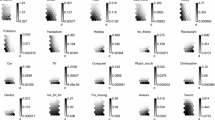Abstract
The aim of this paper is to investigate the economic specialization of the Italian local labor systems (sets of contiguous municipalities with a high degree of self-containment of daily commuter travel) by using the Symbolic Data approach, on the basis of data derived from the Census of Industrial and Service Activities. Specifically, the economic structure of a local labor system (LLS) is described by an interval-type variable, a special symbolic data type that allows for the fact that all municipalities within the same LLS do not have the same economic structure.
Similar content being viewed by others
References
Bagnasco A (1977) Tre Italie. La problematica territoriale dello sviluppo italiano. IL Mulino, Bologna
Becattini G (1996) I sistemi locali nello sviluppo economico italiano e nella sua interpretazione. Sviluppo Locale 2–3: 5–25
Becattini G (2004) Industrial districts. A new approach to industrial change. Edward Elgar, Cheltenham
Billard L, Diday E (2003) From the statistics of data to the statistics of knowledge: symbolic data analysis. J Am Stat Assoc 462: 470–487
Bock HH, Diday E (2000) Analysis of symbolic data. Springer, Berlin
Chavent M, de Carvalho F, Lechevallier Y, Verde R (2006) New clustering methods of interval data. Comput Stat 21: 211–229 (Physica-Verlag)
de Carvalho F, Lechevallier Y, Verde R (2004) Clustering methods in symbolic data analysis. In: Banks D, House L, McMorris FR, Arabie P, Gaul E (eds) Classification, clustering, and data mining applications. Studies in Classification, Data Analysis, and Knowledge Organization. Springer, Berlin, pp. 299–317
Dei Ottati G, Grassini L (2006) Le trasformazioni industriali negli anni Novanta Un confronto fra sistemi locali di grande impresa e distretti industriali. In: Filippucci C (eds) Mutamenti nella geografia dell’economia italiana. Franco Angeli, Milano, pp. 135–157
Dei Ottati G, Grassini L (2008) Italy’s employment changes in the nineties: a comparison between large enterprise areas and industrial districts. Envir Plan C 26: 5
Diday E (2002) An introduction to symbolic data analysis and the SODAS Software. Electron J Symbol Data Anal n.0
Diday E, Noirhomme-Fraiture M (2008) Symbolic data analysis and the SODAS Software. Wiley, New York
Dunford M, Greco L (2005) After the three Italies: wealth, inequality and industrial change. Blackwell Publishing, Oxford
Facchinetti G, Mastroleo G, Paba S (2000) A fuzzy approach to the geography of industrial districts. Applied Computing Symposium, Como, Italy. http://www.acm.org/conferences
ISTAT (2006) Rapporto annuale 2005. ISTAT, Roma
ISTAT (2007) Rapporto annuale 2006. ISTAT, Roma
ISTAT-Sforzi F (1997) I sistemi locali del lavoro 1991. ISTAT, Roma
Merino F, Rubalcaba-Bermejo L (1999) Business services in European economy. European Commission, Brussels
SODAS (2004) User manual for the SODAS 2 Software. ASSO/WP3/D3.4 b, ASSO (Analysis System of Symbolic Official Data) Project [IST-200-25162]
Author information
Authors and Affiliations
Corresponding author
Rights and permissions
About this article
Cite this article
Giusti, A., Grassini, L. Cluster analysis of census data using the symbolic data approach. Adv Data Anal Classif 2, 163–176 (2008). https://doi.org/10.1007/s11634-008-0024-5
Received:
Revised:
Accepted:
Published:
Issue Date:
DOI: https://doi.org/10.1007/s11634-008-0024-5




